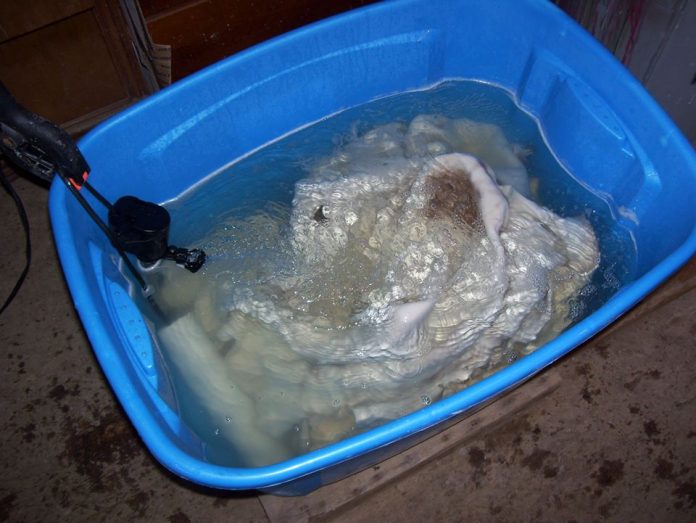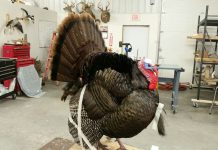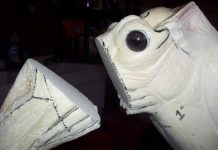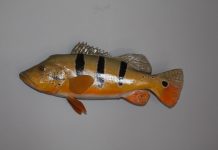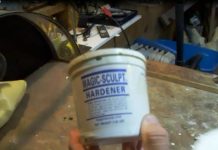A lot of questions I see on the Facebook taxidermy groups this time of the year pertain to pickling and tanning during the winter months. If you’re tanning inside a climate control room that has access to heat 24/7 then this article will be of little use to you. But if you’re like me and don’t run heat 24/7 inside the shop or do you’re tanning outside in a shed or cold garage, then by all means read on.
If I had to choose between a pickle or tan on which one would get the heat and I could only choose one or the other it would be the tan. And that’s only if I’m doing a submersible tan like with Lutan FN and not a brush on tan. A brush on tan like Pro-1 is a totally different animal when it comes to tanning and your deer cape would be required to be inside a climate control room to complete the process.
I don’t worry too much about my pickle temps. Once salt is dissolved in the initial pickle mix of hot water it does not come back into a solid state or as I have heard from others “falling out of the solution”, when the temp of the pickle drops. What does happen in very cold weather is the salt volume of the mixture (40%) in a very cold pickle will sink to the bottom of the pickle. I have had pickle solutions over the deep cold winter month’s ice up if left unattended for a period of time. Pickle vats that are not raised off an uninsulated floor will ice up quicker. The acidity of the pickle will however not be effected by the cold temperatures. If you attend to your pickle baths daily by agitating the pickle with your deer capes, you will be fine and should not see any ice up from a cold shop.
I have pickled deer capes during the dead of winter in my taxidermy shop with water temps dipping well into the low 30’s. I am well known to leave hides and capes in a pickle for weeks and months at a time. Sometimes for a year or more and no I don’t worry ever about acid swelling. A deer cape will on average absorb all the acid it will hold within 4 to 5 days. If you mix in the right amount of salt with your pickle and it all dissolves during the pre-mix, you should be good to go. At any time during the pickling process you can check the salinity of your pickle if you become too worried. I like to be around the 40% mark on the salinity meter for all my pickles. To get that ratio mix one full measuring cup to one gallon of water. Not one cup in measurement but fill the entire measuring cup to the top, pass the one cup mark. You should have about a pound of salt per cup. To repeat mix your acid and salt with hot water to get all ingredients to dissolve. Five to eight gallons of water per deer cape is about what you want for a pickle. Always allow the pickle solution to cool to room temp before placing a raw cape into the pickle.
Before I pickle any cape or hide I will wash and rinse them using cold water and Kemal 4 to remove blood and dirt. By doing this you will give your pickle a longer life and will not see too much of a pH rise. Dirty pickles will live a short life and will require heavy monitoring for pH rise. Pickles should always look clean and not brown or dirty.
So once our deer cape is pickled and shaved it’s time to move onto the tanning. We might have gotten away with a cold pickle in the shed or garage, but if tanning with a submersible tan like Lutan FN we will need a little heat. Don’t worry if your situation requires you to do your tanning in an unheated garage, shed or even in the basement because we have a solution to keep your tanning solution warm.
In this day and age you either have a Wally World with a good size pet section or a brand name pet store within driving distance. Perhaps both stores are within town. If you have a brand name pet store go to the pet store because they have a better selection of what you’re going to need to buy. But first while on the way to the pet store stop on by your favorite dollar store and grab a plastic tote like seen in the featured picture of this article. Oh and be sure to stop at a building supply and buy a short length of 2 inch PVC pipe. They do sell these pipes in 1 or 2 foot sections. At least my Home Depot does.
At the pet store you will need to buy a fish tank heater that can heat water as high as 80 to 85 degrees and is capable of doing that in 3 to 4 gallons of water. You will next buy a power head also located in the fish supply isle of the pet store. The power head will be used to keep your warm tanning water circulating during the tanning process.
That piece of PVC pipe you bought will need holes drilled into it, ½ or ¾ in size. No rhythm or rhyme on the holes, drill as many as you like. Our tank heater will sit inside the PVC at the bottom of our tanning bath. The pipe is to avoid any direct contact with the tank heater and deer cape while in operation.
The power head will suck up water from the bottom of the unit and spray it out on top continuously. To get it to work just right will require you to make the proper adjustments by raising it or lowering it etc. Once in the correct height inside the tote, I use a spring clamp to hold it. Any deer hair in the tan can and will clog the power head. On my set up I attached a plastic hose to the bottom with a screen. Collagen can also be an enemy of the power head. To get the power head going submerge the entire unit to allow all the air to escape from the unit, the slowly raise the power head above the water line.
This set up will solve your cold weather dilemmas. You will constantly have a heated tan but you must keep the lid on at times during the tanning process as the water in the tan will evaporate. In 18 hours you will have a fully tanned deer cape, provided it was pickled and shave correctly. Do not keep the deer cape in the tan for any more then 16 to 18 hours.
When tanning one deer cape mix 4 gallons of water, 6 dry measured ounces of Lutan FN and 2 lbs of salt is all you will need. Mix this all up well before putting in your pickled deer cape.
Any submersible taxidermy tanning agent like Lutan FN requires warm water to be effective. This set up explained and describe will provide you with just that. What happens to our own bodies when we take a hot bath? We become pruned and for some of us bloated. This is exactly what is happing to our deer capes in the hot tanning bath. They are plumping up and by plumping up the fiber structure is expanding. This makes for great penetration of the Lutan FN.
Tips I have for tanning with Lutan FN is not to neutralize between pickle and tan. After you have allowed the pickled cape to drip dry for an hour, place immediately into the tan. Your Lutan FN solution should be around a 3 pH when mixed. This will start to basify the cape while tanning. After you pull your cape from the tan go ahead and neutralize in the shop sink using 1 ounce of baking soda and a ½ pound of salt per gallon of WARM water. The golden rule is to neutralize for 20 minutes and no more. That’s totally up to the tanner but I actually go by the feel of the cape. A neutralized cape will have good stretch and a totally different texture then when acidic. It will feel slick and slippery. Make sure you also get the hair side of the cape when neutralizing also.
Work the deer cape good. Do not walk away from the sink. Swish and agitate around frequently while pretending to be a washing machine. You may notice some white pieces of flesh floating around or stuck to the hair. This is normal and it is what we call collagen.
After you are sure your deer cape is neutralized wring it out and allow to drain. Your next step will be oiling, but that will not be until you have the cape pretty much dry to the point that the flesh side is damp.
Good luck and happy tanning.

